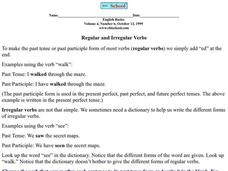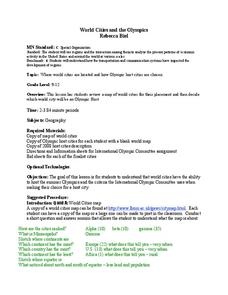Curated OER
Predicting the Route of the Monarch's Spring Migration
Students consider the habits of the monarch butterfly and predict the path it take as it migrates in the spring.
Curated OER
Treasure Hunt
In this treasure hunt worksheet, students fill in the blanks with the correct coordinates. As students fill in the coordinates, they trace their route on a treasure map.
Curated OER
Digging For Dinosaurs
In this dinosaur themed worksheet, students work together as a team of paleontologists to draw the dinosaur bones they discovered at a dig site. They must label their drawing on a grid map and then provide data about the length and...
Curated OER
South American Indian Empires
Students study South American Indian Empires. In this South American Indian Empires lesson, students access an interactive web site to determine the answers to a drag and drop activity. They locate the Mayas, Inca, and Aztecs on a blank...
Curated OER
"Place the State" Game
Students participate in a computer game in which they locate and place the U.S. states on a blank outline map. In small groups, they take turns dragging and dropping the states in the proper location on a map.
Curated OER
Learning About the Equator, The Seven Continents and the Four Oceans
Students use a globe or map to locate the equator, oceans and continents. Using the internet, they spend time surfing through predetermined websites on continents and oceans. They write facts on different parts of the globe on index...
Curated OER
Weather Patterns and Acid Rain (or What is Chicago's acid rain doing in the Adirondacks?)
Students examine a color-coded map of U.S. acid rain precipitation intensity. Using EPA data table and the blank U.S. map, they record state-by-state values for magnitude of emissions and compare areas of emissions to areas with the most...
Curated OER
Mind Libs
Students are told that they are going to do a fun activity similiar to "Mad Libs" in which they "fill in the blanks" to create funny stories. They are given a copy of Mind Libs Reproducible #1. Students follow the word suggestions in...
Curated OER
Regular And Irregular Verbs
In this verb worksheet, students focus on regular and irregular verbs. Students complete 12 fill in the blank sentences using the correct verb format in each.
Curated OER
Sneetches by Dr. Seuss
Students read "Sneetches" by Dr. Seuss. They complete a story map and write about the topic of prejudice. They role-play star-bellied and plain-bellied sneetches and write a persuasive essay about their experiences.
Curated OER
Weather Prediction
In this weather worksheet, students review vocabulary words and concepts associated with predicting the weather. Students understand what a meteorologist studies. This worksheet has 7 matching, 10 fill in the blank, and 5 short answer...
Curated OER
Shopping for Souvenirs In the Middle East
Learners participate in a role play in which they are shopping for souvenirs in the Middle East. Using maps, they locate the Middle East and identify each country within the region. They create a key map for the types of souvenirs that...
Curated OER
World Cities and the Olympics
Students examine the various cities in which Olympics have been held. Using a map, they describe the reasons why those cities were chosen and choose their own city for the Olympics and state the reasons why. They examine information...
Curated OER
Four Learning Styles
Students play a game where they insert the states of the United States onto a map, and discuss the four learning styles as they play. In this learning styles lesson plan, students discuss how each learning style would play and think...
Curated OER
Canada's Landform Regions
Students identify and describe the processes that created the landform regions in Canada. They map the regions and research one region to discover more about it. They present their findings to the class.
Curated OER
Displaying Data
Students create a display map with data from a previous lesson. They incorporate graduated marks that identify areas of the school grounds that are good for planting based on density.
Curated OER
U.S. History: Industrialization and Entrepreneurship
Eleventh graders investigate industrialization and explain how laissez-faire policies influenced entrepreneurship. On bubble maps, 11th graders locate causes of industrialization. In an activity/demonstration, students role-play as...
Curated OER
Farming - Ireland
In this farming worksheet, learners explain what is meant by sustainable development. Students review how rain develops. Learners determine how climate effects crops that can be farmed. This worksheet has 4 graphic organizers, 1 graph,...
Curated OER
Giving and Taking Directions
Students identify the difference between commands and a declarative sentence. They complete a diagram with verbs, prepositions and numbers. They follow directions using a map and give directions to another location.
Curated OER
Giving and Taking Directions (Middle School)
Students describe the difference between a declarative sentence and a command. They complete a diagram verbs, prepositions and numbers. They follow directions on a map and create directions of their own to another location.
Curated OER
Canada's Landform Regions
Students use a atlas to identify and describe Canada's Landform region. Using the information they collect, they create a thematic map of the region and describe all of the physiographic regions and the processes that formed them. They...
Curated OER
Dead Sea Investigation: Middle East and African Connections
Students demonstrate comprehension of the physical characteristics of the Dead Sea region and its connection to the Red Sea and the African Great Rift Valley. They are given students the opportunity to understand the role of plate...
Curated OER
Human Heredity Traits
Completing an idea map based on various inheritance factors and mistakes, 9th graders review their knowledge of genetic disorders. While the activity is based on chapter 15 of an unnamed textbook, the questions at the bottom of the page...
Curated OER
Voyage to the New World
Middle schoolers examine the exploration of the New World. They write a descriptive account of the first encounter between Europeans and Native Americans, analyze and label maps, plot Columbus's journey on a map, and write a chapter...

























